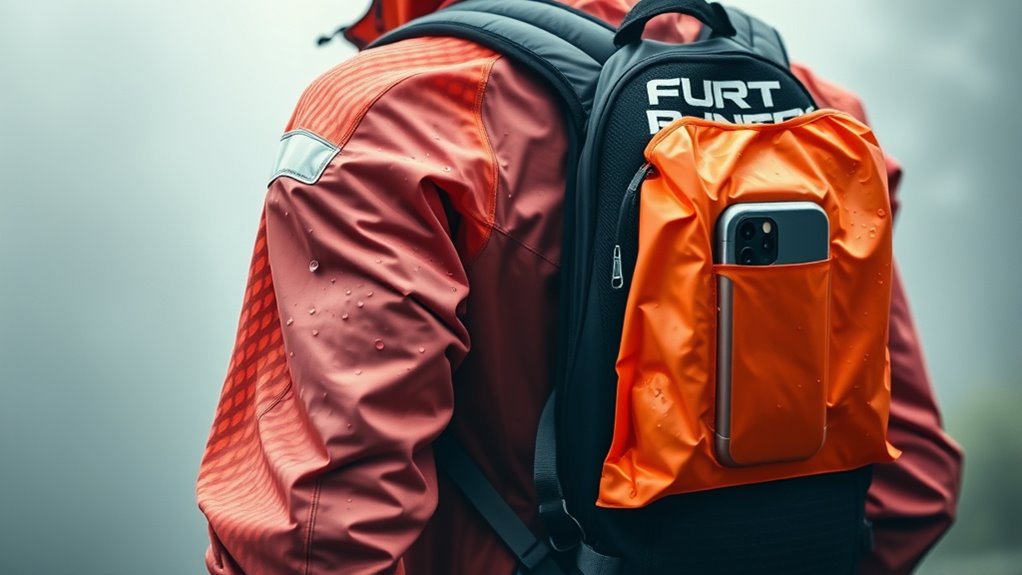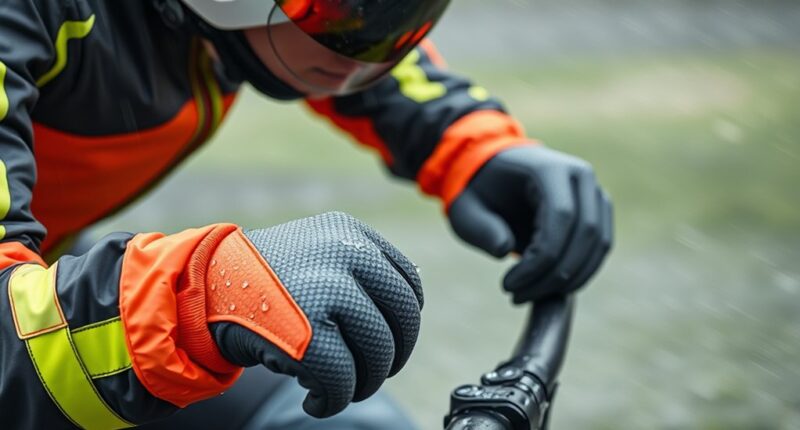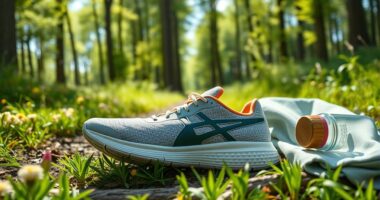To stay dry during rainy runs, you should use weather-resistant gear like sealed-seam backpacks or belts with waterproof compartments to safeguard your essentials. Invest in waterproof footwear such as shoes with Gore-Tex membranes or gaiters to keep your feet dry and prevent blisters. Carry a foldable rain poncho or emergency jacket for quick coverage. Combining these strategies ensures you stay comfortable and dry, making it easier to enjoy your run despite the weather. Learn more to perfect your setup.
Key Takeaways
- Use weather-resistant bags or backpacks with sealed seams to store and protect your essentials from rain.
- Wear waterproof footwear such as Gore-Tex shoes or gaiters to keep feet dry and prevent slipping.
- Carry a foldable rain poncho or emergency rain jacket in your pack for quick coverage if weather worsens.
- Incorporate waterproof materials in your gear to prevent moisture seepage and keep electronics and clothing dry.
- Combine waterproof footwear with rain gear storage for a comprehensive setup that ensures comfort and dryness during rainy runs.

When rain starts falling during your run, having the right gear setup can make all the difference between a miserable workout and a comfortable, enjoyable experience. The key is to be prepared with effective rain gear storage and waterproof footwear options that keep you dry and motivated, even in wet conditions. Starting with rain gear storage, it’s essential to choose a weather-resistant bag or pack. This way, you can carry extra clothing, a towel, or even electronics without fear of water damage. Look for backpacks or running belts with sealed seams or water-resistant compartments—these keep your essentials dry no matter how heavy the rain. Compact, quick-drying materials are ideal for storage options, so you can stow wet gear away easily once you’re done, without letting moisture seep into your other belongings. It’s smart to keep a small, foldable rain poncho or emergency rain jacket tucked into your pack, ready to deploy if the weather worsens unexpectedly. This allows you to adapt on the fly, maintaining comfort without stopping your run. Incorporating waterproof materials into your gear can further enhance your protection from the elements, ensuring you stay dry throughout your workout.
Moving on to waterproof footwear options, your choice of shoes can considerably influence your comfort and safety during a rainy run. Traditional running shoes tend to absorb water, becoming heavy and uncomfortable, which is why investing in waterproof footwear options makes a big difference. Look for shoes with waterproof membranes, like Gore-Tex or similar technologies, that allow moisture to escape from inside while blocking external water from entering. These shoes keep your feet dry and reduce the risk of blisters caused by wet socks. Some runners prefer waterproof trail shoes with aggressive tread patterns for better grip on slippery surfaces, preventing slips and falls. If you don’t want to invest in specialized footwear, consider adding waterproof shoe covers or gaiters. These slip over your existing shoes and provide an extra barrier against puddles and mud, especially useful when running on trails or uneven terrain. Remember, the fit of waterproof shoes is vital—ensure they’re snug but not tight, to allow for swelling and comfort over long distances in wet conditions.
Ultimately, staying dry during a rainy run depends on your gear choices. Proper rain gear storage guarantees your belongings stay dry and accessible, while waterproof footwear options keep your feet comfortable and protected. By combining these strategies, you’ll be prepared to face rainy weather head-on, turning potentially miserable runs into opportunities to enjoy fresh air and exercise regardless of the forecast. With the right setup, you can embrace the rain instead of avoiding it, making your runs more consistent and enjoyable year-round.
Frequently Asked Questions
How Do I Choose the Best Rain Gear for Different Climates?
To choose the best rain gear for different climates, consider fabric breathability and waterproof material. In warm, humid areas, opt for lightweight, breathable fabrics to prevent overheating. For colder, wetter climates, prioritize gear with high-quality waterproof materials that also wick moisture away from your skin. Always check product ratings for breathability and waterproofing, and select gear suited to your activity level and weather conditions to stay comfortable and dry.
What Are the Maintenance Tips for Prolonging Rain Gear Lifespan?
Think of your rain gear as a trusty companion that needs care. Regularly clean your gear to remove dirt and buildup, preventing damage. Spot treat small tears promptly and store it in a cool, dry place, avoiding direct sunlight. Proper gear cleaning and storage tips extend its lifespan, ensuring you’re always prepared for rain. A little maintenance now saves costly replacements later—like tending a garden to keep it thriving.
Can Rain Gear Be Layered for Better Insulation?
Yes, you can layer rain gear for better insulation. Use layering techniques like adding a lightweight, moisture-wicking base layer, a warm mid-layer, and a waterproof outer shell. This setup enhances insulation benefits, keeping you dry and warm in cold rain. Make certain each layer fits well without restricting movement, and choose breathable materials to prevent sweat build-up. Proper layering ensures comfort and protection during wet, chilly conditions.
How Does Rain Gear Impact Running Performance?
Rain gear can slightly impact your running performance by causing breathability issues and adding weight. You might feel warmer and more restricted, which can slow you down or cause discomfort. To minimize this, choose lightweight, breathable rain gear designed for runners. Layering wisely helps, but be mindful of how much weight you carry and guarantee your gear allows for proper ventilation to stay comfortable and maintain your pace.
Are There Eco-Friendly Rain Gear Options Available?
Think of eco-friendly rain gear as a shield woven from the earth’s own fabric. You’ll find options made from biodegradable materials and recycled fabrics that protect you without harming the environment. These choices reduce waste and lower your carbon footprint. By choosing sustainable rain gear, you support eco-conscious brands and help keep nature’s runway clear, so you can run with the wind in your hair and a lighter conscience.
Conclusion
Staying dry during rain runs is all about choosing the right gear and setting it up properly. With the right waterproof jacket, moisture-wicking base layers, and well-positioned accessories, you’ll stay comfortable no matter the weather. Did you know that over 60% of runners experience discomfort from rain, yet proper gear can reduce this by half? Investing in your rain-run setup not only keeps you dry but also boosts your confidence, so you can enjoy every mile, rain or shine.









